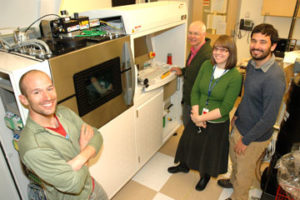 The revolution in 3D printing—a manufacturing process in which “printers” build plastic or metal components—has taken a big step forward with a new machine purchased by the Anschutz Medical Campus in Colorado.
The revolution in 3D printing—a manufacturing process in which “printers” build plastic or metal components—has taken a big step forward with a new machine purchased by the Anschutz Medical Campus in Colorado.
A news release from the University of Colorado (which houses the medical center) aptly summarizes the potential: “Metal Prototype Machine Could Revolutionize Biomedical Research.” The “laser metal sintering machine” functions by heating metal powder, causing it to cohere in thin sheets of “printed” metal that can be built, layer by layer, into intricate designs. (See the Denver Post’s report for additional details.) The printer is able to build components from titanium, nickel, magnesium, and cobalt.
The medical center focuses on using the machine to develop “prosthetic fingers, hands and arms.” But the technology has far broader possibilities. Once an individual or a group of designers can design and manufacture custom metal and plastic components, they can quickly, easily, and inexpensively produce kinds of machines and tools that already exist—and an unlimited number of machines and tools that have yet to be invented.
Richard Weir, a bioengineer with the university, said of the technology:
It's a whole new way of thinking about how to make things. . . . The revolutionary aspect is to be able to do stuff that you can't using conventional technology. There is the possibility to fabricate impossible-to-machine components and to explore whether that confers advantage to the designs we're working on.
The machine purchased by the medical facility was built by the German company EOS, which calls the technology “e-manufacturing.” The company explains:
Global markets are facing ever shortening product life cycles. At the same time, product variety is on the rise. Manufacturing methods based on economies of scale are no longer in the position to meet these challenges. The credo underpinning conventional manufacturing means selling high volumes of identical products. This prerequisite, however, can no longer be met in today's competitive environment.
Tool-based manufacturing methods are not suitable for economically fulfilling the increasing demand for customized products. Both product development and manufacturing therefore have to shift their paradigms—moving away from tool-based, static methods in favour of generative and flexible methods. e-Manufacturing can achieve this.
If you’ve ever wondered what it was like to witness the development of a profound technology, whether the automobile, electricity, aircraft, or microcomputer, wonder no more. This—observing the 3D printer revolution—is what it’s like.
Congratulations to EOS for developing this wonderful, world-changing technology, and congratulations to the Colorado researchers working to apply the technology in the field of medicine. What’s next we can only imagine. What has to date been impossible to manufacture is now possible.
Like this post? Join our mailing list to receive our weekly digest. And for in-depth commentary from an Objectivist perspective, subscribe to our quarterly journal, The Objective Standard.
Related:
- Energy at the Speed of Thought: The Original Alternative Energy Market
- The Burgeoning Micro-Production Revolution
- Herman Boerhaave: The Nearly Forgotten Father of Modern Medicine
Image: University of Colorado, Denver


![[TEST] The Objective Standard](https://test.theobjectivestandard.com/wp-content/uploads/2017/10/logo.png)










